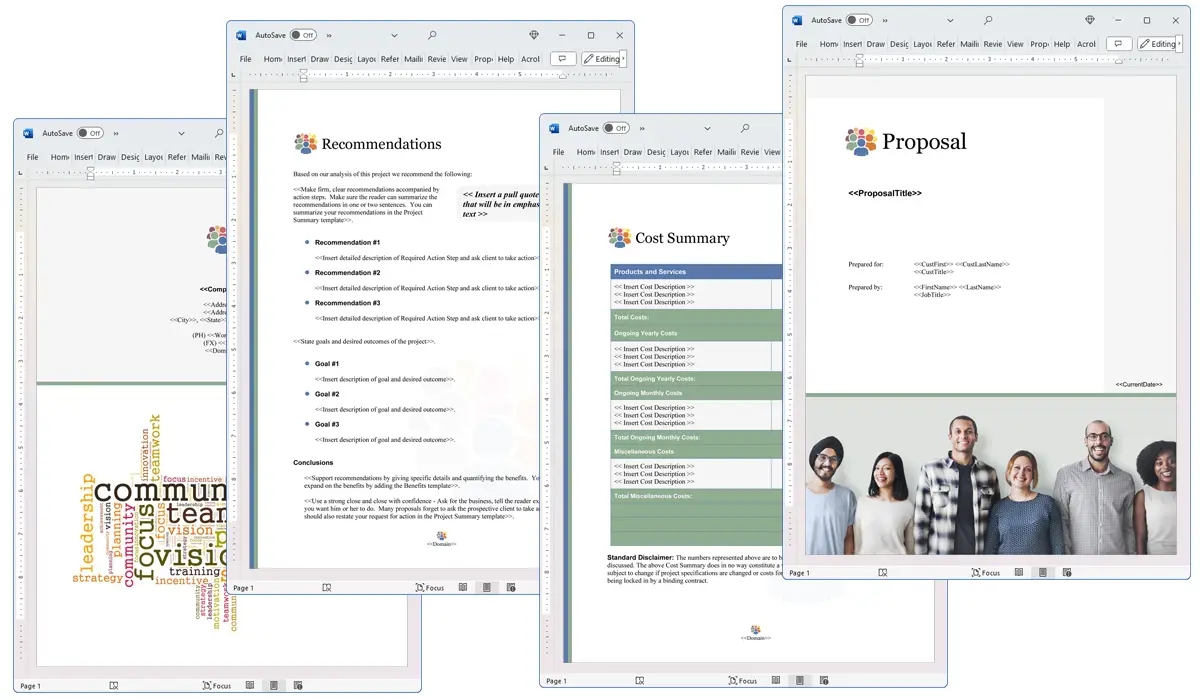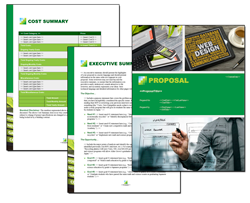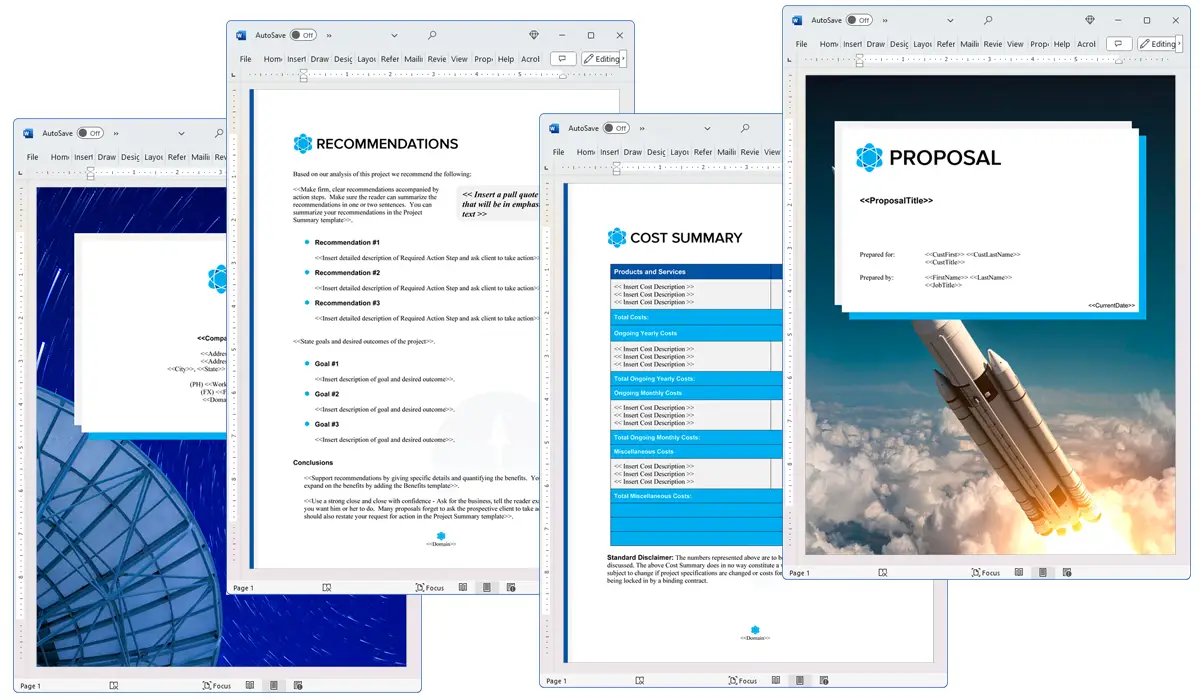What is the Human Error chapter used for?
Proposal Kit Professional Bundle adds more design themes, all six Contract Packs,
a project management library, and Expert Edition software.

Illustration of Proposal Pack Community #1
We include this Human Error chapter template in every Proposal Pack, along with thousands more. You assemble this chapter with others in various combinations to create custom-tailored business proposals, plans, reports, and other documents. Proposal Packs apply custom visual designs to the templates, giving the final documents a consistent professional finish.
 DOWNLOADABLE, ONE-TIME COST, NO SUBSCRIPTION FEES
DOWNLOADABLE, ONE-TIME COST, NO SUBSCRIPTION FEES
Overview of the Human Error Chapter
The Human Error chapter is an important component in the creation of comprehensive business proposals, particularly when addressing topics related to security, safety, or any area where human involvement plays a significant role in operational outcomes. This chapter template helps organizations articulate potential or existing issues that arise due to the actions or inactions of personnel. It provides a structured way to discuss the implications of human error, thereby enhancing the understanding and mitigation strategies within business proposals.
How is the Human Error Chapter Used?
In business proposals, the Human Error chapter is typically used to outline how human mistakes can impact various aspects of operations, projects, or processes. It serves as an important analysis tool that helps businesses identify areas where human error could or has led to undesired outcomes. By documenting these instances, companies can propose necessary changes or solutions to improve safety, security, and overall efficiency. This chapter is also instrumental in building the case for why certain measures, such as training or new policies, need to be implemented to reduce the risk of human error in the future.
What is Included in the Human Error Chapter?
This chapter generally includes:
- A detailed description of identified human errors within the organization or project.
- The consequences of these errors on operations, safety, security, or financial health.
- Analysis of the root causes of these human errors.
- Proposed measures or solutions to mitigate the risk of future errors.
- Case studies or real-life examples where human error had significant implications, helping to underline the importance of addressing these issues.
Use Case Examples for the Human Error Chapter
- Aerospace: Proposing new compliance measures after a review of human errors that led to equipment misuse or safety protocol violations.
- Finance: Outlining the impact of data entry errors on financial reporting and the subsequent financial controls implemented.
- Insurance: Analyzing claims incidents where human error contributed to underwriting losses, proposing enhanced training for claims handlers.
- Legal: Documenting procedural errors in legal documentation handling and advocating for automated compliance checks.
- Security: Addressing breaches resulting from human error in security protocols, proposing advanced security training and automated systems.
- Safety Plans: Creating enhanced safety protocols following an analysis of workplace accidents attributed to human error.
- Reports on Construction: Discussing human error in project delays or safety incidents, suggesting improved project management methodologies.
- Studies on Healthcare: Evaluating medication administration errors and recommending technology to improve accuracy.
- Problem Analysis in IT: Analyzing downtime caused by human error in system maintenance, proposing AI-based monitoring tools.
- Negatives in Manufacturing: Detailing assembly line errors leading to product recalls and suggesting real-time monitoring systems.
Key Takeaways
- The Human Error chapter is vital for addressing the impact of human activities on business operations.
- It helps businesses identify problems, analyze root causes, and suggest practical solutions.
- The chapter is and can be used across various industries including aerospace, finance, and healthcare.
- Real-life examples and case studies enhance the effectiveness of the proposals by providing concrete evidence of past incidents and their implications.
- Ultimately, this chapter aids in improving safety, security, and operational efficiency by focusing on human-centric issues and their resolutions.

Illustration of Proposal Pack Web #4
 What Our Clients Say
What Our Clients SayI bought the Proposal Pack last year in November and I will take this opportunity to thank you for your excellent customer service and the Proposal Pack did obtain the big contract I bought it for and many more. Now my client is so happy with my services that they want to put me on a retainer."
Mychele Rondeau
 4.7 stars, based on 845 reviews
4.7 stars, based on 845 reviewsRelated Chapters

The Human Error chapter and other chapters are integrated into a Word document as illustrated here in the Proposal Pack Aerospace #4 design theme. There are hundreds of design themes available, and every design theme includes the Human Error chapter template.
A proper business proposal will include multiple chapters. This chapter is just one of many you can build into your proposal. We include the complete fill-in-the-blank template in our Proposal Pack template collections. We also include a library of sample proposals illustrating how companies in different industries, both large and small, have written proposals using our Proposal Packs. This template will show you how to write the Human Error.
We include a chapter library for you to build from based on your needs. All proposals are different and have different needs and goals. Pick the chapters from our collection and organize them as needed for your proposal.
Using the Proposal Pack template library, you can create any business proposal, report, study, plan, or document.
 Ian Lauder has been helping businesses write their proposals and contracts for two decades. Ian is the owner and founder of Proposal Kit, one of the original sources of business proposal and contract software products started in 1997.
Ian Lauder has been helping businesses write their proposals and contracts for two decades. Ian is the owner and founder of Proposal Kit, one of the original sources of business proposal and contract software products started in 1997.By Ian Lauder
 Published by Proposal Kit, Inc.
Published by Proposal Kit, Inc.


 Cart
Cart
 Facebook
Facebook YouTube
YouTube X
X Search Site
Search Site